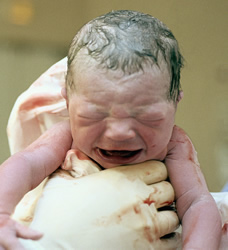In this article, you will find:
Descent, crowning, and birth
The time it takes to push your baby out once he or she is deep within the pelvis can take around 30 minutes to one hour for a first labor, although this time may be considerably reduced in subsequent labors, sometimes taking just a few minutes. The combined force of the contractions (which are now around every two to five minutes) and your pushing moves your baby farther down into the pelvic outlet. As this occurs, the pressure on your back and rectum will intensify and you may experience a stinging sensation as your vagina becomes fully stretched. Your doctor may tell you to stop pushing at this point so that your perineum can thin further and so that the baby's head isn't delivered too suddenly, which could cause serious tears. She may tell you to pant or blow instead to help you resist the urge to bear down.
Crowning
Initially, the head will descend with each contraction and then move slightly back up the birth canal. Eventually, it will descend far enough to be visible through the vagina at the height of a contraction, known as "crowning," before it once again moves back up and disappears. As contractions continue, the head finally stays in the vaginal opening, and from this point it won't be long before your baby is born.
As your baby descends, the chin will be tucked down toward the chest and the head will rotate slightly so that your baby is facing your back; this enables the largest part of your baby's head to pass through the widest part of the pelvis. As the head passes out of the vagina, it extends backward so that it almost touches his or her back. The doctor will check whether the cord is around the baby's neck. If this is the case, it will be lifted up and away from the neck. The doctor will remove any mucus from your baby's nose and mouth. Once the head has been delivered, it will return to its normal position.
Rest of the body
After the delivery of the head, your baby will turn slightly so that the first shoulder can be delivered in the next contraction. Your doctor may help by applying gentle traction to your baby's head at the side to help the first shoulder emerge. Once the first shoulder has been delivered, your baby will turn again slightly so that the second shoulder can be delivered. After this, the rest of the body will slip out and the delivery of your baby will be complete.

Your baby will emerge covered in blood and the thick, greasy substance known as vernix that provided a protective covering for your baby's skin in the uterus.
